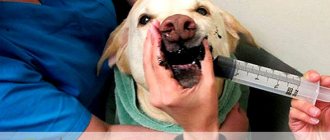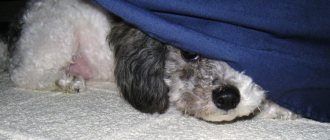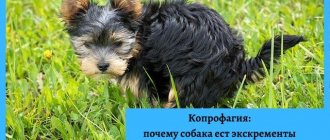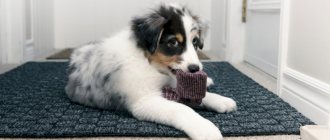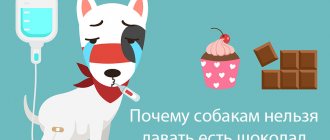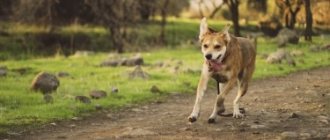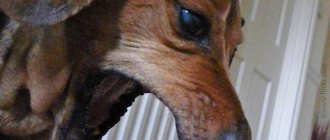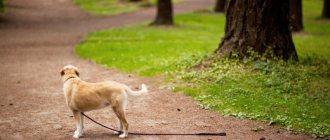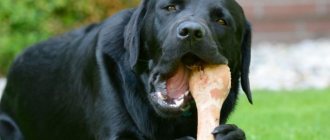Causes of hyperactive behavior in dogs
Hyperactive behavior in a dog is a condition that manifests itself in mild agitation from any, even the most insignificant stimuli. In some cases, this behavior is normal, such as in puppies and young dogs. Adults of some breeds can also behave energetically. High emotional and physical activity can manifest itself in different ways; each breed has its own characteristics.
However, for most dogs, hyperactivity is a mental disorder that requires correction by the owner or specialist. Overactive dogs cannot calmly perceive their surroundings, focus their attention and respond adequately to external stimuli. In addition, the behavior of a hyperactive dog can cause a lot of trouble for the owner.
The main causes of hyperactive canine behavior are as follows:
- genetic predisposition of the breed;
- failure in the hormonal system;
- improper upbringing;
- failure to comply with pet maintenance standards;
- lack of the right environment for the dog;
- lack of attention;
- lack of physical and physical activity;
- disruptions in the functioning of the nervous system (neuralgia);
- rough violent education;
- lack of daily routine;
- diabetes;
- psychical deviations;
- emotional stress;
- poor nutrition, lack of vitamins and minerals in food;
- disturbance of sleep and rest.
In addition to the symptoms described above, hyperactivity in a pet can be caused by a number of diseases, for example, the presence of neoplasms, ectoparasites, and emotional turmoil.
Yorkie shows aggression: causes and solution to the problem
Both at a young age and throughout its life, a dog can exhibit atypical behavior. And although the Yorkshire Terrier breed itself is fairly balanced and generally calm. If your Yorkie is showing aggression, you should get to the root cause before taking any action. In fact, there can be a lot of them: starting from painful sensations, fear and shock and ending with the presence of certain irritants or typical deviations in the behavior of a small dog. In this article we will look at common situations and make a number of practical recommendations.
What is considered aggression in a Yorkie, and what are the reasons for its manifestation?
An attentive owner will immediately notice uncharacteristic behavior. The dog may begin to not only be wary, but also begin to treat family members, passers-by, and other animals on the street aggressively. The first point to consider is that it is wrong to try to interpret the behavior of an animal with human attitudes and norms. No matter how you try to make a “family member” out of your pet, the Yorkshire Terrier continues to remain a dog; albeit small in size. It is important to remember that the Yorkie perceives a certain group of people (for example, a family) as a pack. Therefore, aggressive behavior may be aimed at protecting this flock. Repelling a figurative attack from a stranger is considered hierarchical aggression. Often certain stimuli come from the leader of this pack (head of the family), who may punish the pet excessively. If the pet came into the house recently, especially at an old age, this may indicate its attempt to dominate within the pack.
Sometimes the cause of aggressive manifestations is severe fear, discomfort (painful sensations) or painful shock. If you have an anxious dog with a choleric personality, you're probably very familiar with visits to the veterinary clinic. An irritated pet at such moments can even bite its owner indiscriminately or even inadvertently cause harm to itself. In the process of punishment for misconduct or disobedience, care should be taken to ensure accuracy and proportionality. Small dogs, Yorkies are no exception in this regard, are quite vindictive. Aggressive behavior during attempts at dominance (with the leader of the pack or in the presence of other pets) should not lead to manipulation. Therefore, you should play and feed the dog only when it shows submission and submissiveness. Otherwise, when the pet gets what it wants as a result of aggression, it is postponed on an unconscious level. During the adjustment process, there are many ways to make adjustments at home. This includes scheduled feeding times (strictly according to the schedule), and a ban on lying on upholstered furniture with the owners, and placing a dog bed in a certain place in the living room, and training.
In what cases is a Yorkie most often mischievous?
Yorkies can be aggressive towards children. The reason for this is explained quite simply. In the hierarchical ladder, the young members of the family are below it in the dog’s understanding. Therefore, attempts to play, stroke, cuddle at a time when the animal does not want it (especially during rest and sleep) is fraught with growling and even biting. In this case, corrective measures cannot be avoided. If small children or teenagers do not calculate their strength when trying to raise a dog, this point should be excluded. Do not forget that only the “leader of the pack” should punish the pet. Only in this case will the punishment be perceived correctly. To simulate the situation and hone similar moments, a somewhat rough game is allowed, when you can slightly grab the skin, ears, and then, if aggressive behavior is displayed, it is necessary to apply “punishment.” Accustom your children to walking with your Yorkie in a timely manner and be sure to be present at the first outings.
Harm can also occur in relation to other pets. Moreover, this may not necessarily be the second Yorkshire terrier, but also other “living creatures”: for example, a rabbit, other animals. In this case, it is recommended to try to closely monitor behavior and prevent aggression. You should immediately stop the bully's behavior by letting him know that these actions are unacceptable. Otherwise, harmful behavior that has become a habit will be more difficult to correct later.
When should you correct your Yorkshire Terrier's behavior?
Correction does not have to be strict training. Although, in most advanced cases, some drastic decisions (actions) unfortunately cannot be avoided. It is necessary to choose a suitable obedience course with an experienced specialist. The most optimal age for a Yorkshire Terrier is 3-8 months. But even at a later date, the dog can be adjusted in behavior. It is important not to read opinions and advice on forums that outline the difficulty of changing a dog’s behavior. It's really not easy, but not impossible. Ultimately, everything depends on the owners themselves and an experienced trainer. Do not forget that you will have to live for many years with a dog with a weakened psyche, which is a great discomfort for both family members and the pet itself.
It is worth remembering that Yorkie bites in themselves do not necessarily have to be considered aggression. The fact is that this form of behavior may be typical for a particular dog. This may happen during the game. For puppies, during the change of teeth, this is, in principle, par for the course. But it is important not to miss the moment so that it does not become a habit for a growing Yorkshire Terrier to bite and become aggressive when you want to play/walk/etc.
What to do to correct your Yorkie's behavior? Recommendations and tips
One way is to avoid conflict situations. You, as the owner of the dog, must anticipate their onset: walk around the other animal on the street, feed strictly according to the schedule, do not punish too strictly (do not beat under any circumstances), monitor the state of health. In some cases, it will be necessary to conduct training and exercises to demonstrate to the pet its place and the need to obey. A hierarchical system of relationships must be built. If you can’t cope on your own, contact a trainer or handler. If during the examination, trimming the fur and nails, and combing the Yorkie shows aggression, it is necessary to consistently demonstrate to him the safety and pleasure of the procedure. In this case, you should be patient and teach your dog to react accordingly.
In addition, we recommend that owners of Yorkshire terriers engage in timely socialization of the dog. This will partially neutralize the onset of possible negative consequences. Often people decide to keep their pet entirely at home. Even in this case, it is worth taking your Yorkie for a walk periodically. Otherwise, after some time, the manifestation of aggression will become more frequent. Moreover, for almost any reason. Remember that it is never too late to raise a Yorkshire Terrier.
The Yorkshire Terrier is an adorable little dog that can melt your heart just by looking at you. Many new owners, having bought a Yorkie, believe that they have brought a calm and quiet friend into the house, but in reality everything turns out to be completely different. Despite its miniature appearance, the Yorkshire Terrier is a breed with a serious disposition and sometimes difficult character. Before getting a Yorkie, we recommend that you familiarize yourself with the behavioral characteristics of the animal.
List of active energetic breeds
Each dog breed has different levels of physical and emotional energy. There are breeds that are calm, while others, on the contrary, tend to be very active.
It is believed that the most active dogs are those that weigh no more than 25 kg and no higher than 40 cm at the withers, because... It is difficult for large dogs to run and jump around the clock. The Jack Russell Terrier is considered the most active breed of small representatives. The energy of these dogs is so high that the owner gets tired faster than his pet. This breed was bred for hunting, hence its wild, endless charge of energy. These dogs are good for hyperactive children.
Of the large individuals, the following active breeds are noted:
- West Siberian Laika;
- malamute;
- beagle;
- husky;
- Cocker Spaniel;
- Border Collie;
- pinscher
An interesting fact is that two dogs of the same breed can have different activity levels. Each will have its own disposition and character. In addition, a dog’s energy depends on socialization and living conditions.
Sudden signs of aggression
First of all, let us clarify that not a single dog will bite or growl out of the blue - there must be reasons and prerequisites for such behavior. The exception is animals with serious mental disorders. In all other cases, aggression towards one’s own owner or household members can be caused by unusual actions towards the dog. For example, you have never bathed your dog and decided to do it for the first time when he was already grown up - with a high degree of probability the animal will get scared and begin to defend himself. To prevent this from happening, accustom your Yorkie to hygiene procedures from puppyhood.
Correcting the behavior of a hyperactive dog
A pet's hyperactive behavior is not only harmful to the dog itself, but also poses a problem for the owner. It is difficult to walk with such animals, control their habits, and train them. The dog cannot concentrate on commands, constantly jumps, and does not obey.
There are several effective methods for reducing hyperactive behavior in dogs. It's best to use them all. The list of measures to calm an overactive pet is as follows:
- Controlling your own behavior. Since dogs are very sensitive, they perfectly recognize the mood of their owner and adapt to it. For example, a calm person will have a calmer dog, and vice versa. Being in an extreme state of excitement, a dog can do anything. This is why it is so important to monitor your behavior, feelings and thoughts;
- Special toys. Most owners of various dog breeds believe that only young dog breeds need toys. But this is a mistaken opinion. At any age, a dog is interested in balls, bones and sticks. A rope and a tourniquet will make excellent crackers. But for young puppies it is better to refuse such toys, since the correct bite may be disrupted;
- Ignore and do not reinforce overactive behavior at home. Many pets, when they see their owner after work, begin to actively jump, run, jump and playfully bite. Of course, such behavior in the first 5 minutes is justified; the animal missed its owner, and this is normal. But if this continues for a long time, you should ignore this behavior, do not look the dog in the eyes and avoid contact in every possible way, without encouraging unwanted behavior;
- Aromatherapy method. Essential oils from plants have a calming effect on the entire body, including the dog’s. In order not to make a mistake with your choice, it is recommended to visit a veterinarian who will prescribe the appropriate oils;
- Physical activity. One of the best methods to combat hyperactivity. The dog's high energy is due to idleness and lack of constant work. Especially if the pet lives in a city apartment and rarely goes for walks. Therefore, a competent owner will find the right direction for his pet, where all the unspent energy will go. At the pet store you can buy a special dog backpack that a hyperactive dog will wear on walks. You can also go to a pond or river for your dog to swim. After such an active workout, the dog will fall asleep like a baby and sleep without getting up until the morning.
Physical activity and walks are essential for dogs every day.
Features of education and training
It is important to realize that hyperactivity is a chronic condition that lasts several months. If your dog becomes agitated under certain circumstances or reacts noticeably to specific stimuli, you should work to eliminate the negative factors. Smart and sensitive pets who need fun activities and interesting stimuli are often misdiagnosed. In the absence of new impressions, the dog will find them for itself, even in the absence of the owner:
- will turn over the trash can;
- will damage furniture and curtains;
- will begin to chew on objects that are at an accessible distance.
A repetitive walking route makes your pet bored, so he will pester strangers or run off to meet exciting adventures. The dog does this not out of spite or out of spite, but out of banal boredom. Animal psychologists suggest how to correct the situation:
- It is necessary to buy a variety of toys, even if the pet is beyond a small age. The accumulated energy will splash out on sticks and balls, and not on the home interior and owner.
- If the animal loves to swim, it is useful to organize a trip to a pond in the warm season. The activity takes a lot of energy, so upon returning home your pet will be sound asleep.
- Regular walks should be diversified by changing the route or inventing new tasks.
- At moments of peak activity, experts recommend ignoring a dog that begins to show signs of attention. If this serious test is not passed, the animal will understand that it can achieve what it wants through obsessive behavior.
Over time, a loving owner will be able to calm their pet without injury or stress.
Does your Yorkshire Terrier constantly ruin things?
Many owners, perceiving the Yorkshire Terrier as a cute toy, keep the dog in the apartment all day long. In such situations, the Yorkie is often left alone at home, with no one to play with or educate him. Finding itself in such conditions, an active dog with a natural craving for adventure and adventure is constantly looking for something to entertain itself. Activity is expressed in restless behavior, whining, damage to furniture, things, and even relieving oneself in inappropriate places. The only way to fight in this case is to pay more attention to the animal and take it for long walks so that the Yorkie can play enough.
Having decided to get a mischievous Yorkie, remember that representatives of this breed need increased attention from the owner. Considering themselves at least a German Shepherd, these cute kids are endowed with a decisive character and demand to be treated accordingly.
Convulsions and foaming at the mouth in a dog
Convulsive spasms most often accompany diseases such as eclampsia, epilepsy, diabetes mellitus (hypoglycemia), and tumors. Convulsions and foam can also occur due to poisoning, severe infestation, allergies to drugs and side effects of medications.
The secretion of saliva and foam can be triggered by physical overload, heat stroke, or eating toxic garbage or sharp objects (stomach trauma).
It is necessary to carefully monitor your pets during walks, and also use medications only as directed or coordinate treatment with a specialist.
How can you tell if your dog is excited?
An attentive owner immediately notices changes in his dog’s behavior. However, the reaction to different stimuli differs. Behavior is also influenced by heredity, gender, upbringing, and breed characteristics.
In an overexcited state, the pet:
- constantly barks or whines;
- trembles;
- the hair on the withers stands on end;
- curls ears and tail;
- has dilated pupils.
Expert opinion
Kuzmenko Olga Olegovna
Information about the expert
Ask a Question
If the dog is very frightened, it loses control of urination, so incontinence is possible. In rare cases, uncontrollable bowel movements. You can’t scold your pet here; your main task is to calm him down.
Additional questions
What is a Calming Diffuser for Dogs?
A calming diffuser for dogs is a special electronic device that diffuses a pheromone that calms the dog. It works like a fumigator or air freshener.
What medications can calm a dog?
You can use medications such as VetSpokoin, Stop-stress, Beaphar NO STRESS, Valerian or peppermint. But there is no need to self-medicate. All medications must be prescribed exclusively by a veterinarian.
Treatment
A course of treatment and preventive procedures are prescribed only after a full examination and passing the necessary tests. It is important to remember that cramps are not a cause, but a pronounced symptom. If an incident is left unaddressed, it could be much worse next time.
Research:
- taking anamnesis;
- examination by a surgeon, therapist, neurologist;
- ECHO;
- blood, urine, stool analysis;
- CT;
- Ultrasound of internal organs;
- X-ray;
- MRI.
The main thing is to treat prescriptions and treatment with the utmost rigor. Don't rely on chance. It is necessary to strictly follow the recommendations and only then there is a chance that the attacks will decrease or disappear completely.
| A drug | Indications for use | Purpose | Dosage |
| Phenobarbital | epilepsy (all types of seizures except absences), seizures of non-epileptic origin; | Treatment, supportive care | As prescribed by a veterinarian |
| Pagluferal | |||
| Primidon | |||
| Phenytoin (Dilantin) | |||
| Magnesium sulfate (Magnesia) | Convulsions | Urgent help | 1–2 ml by weight/intramuscular injection. Slow introduction |
| No-shpa | Spasms | Urgent help | 1 ml per 10 kg intramuscularly |
| Motherwort, valerian | Sedative | Urgent help | 5 drops per 10 kg |
| Activated carbon | Absorbent for poisoning | Urgent help | 1 t per 1 kg (after gastric lavage) |
It is important to remember that all appointments must be agreed with a veterinarian. If it is not possible to take the animal to the hospital, then you need to get advice and instructions by phone.
Does your Yorkie avoid other dogs and doesn't want to go outside?
The problem is the socialization of the animal. In the process of raising a dog, it is necessary to provide it with frequent communication with other animals. If you keep your Yorkie isolated from the outside world from two to four months, then as an adult he will begin to avoid other dogs. The dog, accustomed to a warm and quiet home, simply does not understand that you forgot on the street, because everything he needs is left in the apartment, including food, toys, a tray and a sleeping place.
Even if the moment of natural socialization is missed, with the right approach, a Yorkie can be accustomed to the street, the company of other dogs and strangers.
Try to walk your Yorkie regularly, at least once a day, to avoid problems with socialization.

